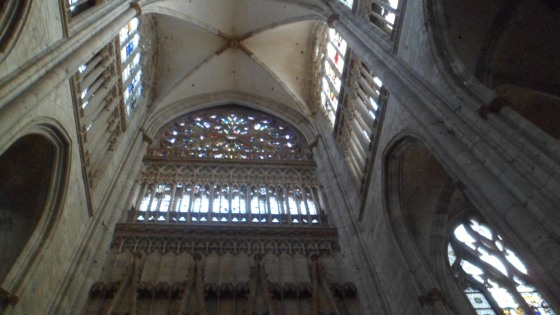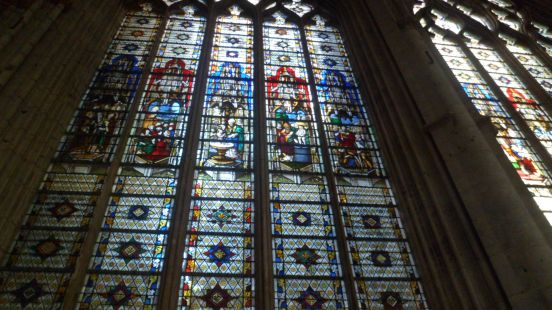July 17, 2014
-
An Eastward Homage, Day 10, Part 2: Coming to an Ancient Home
In about 1650, three brothers left Rouen, France and joined a sailing expedition to the thriving French settlement of Quebec. They were roofers, and as such, made a thriving business in the emerging French colony. Their descendants would spread to Montreal, Ottawa, New Brunswick and Prince Edward Island, and from those haunts, the Boivins spread throughout North America, into Mexico and among various Caribbean islands. Today, the surname is common enough, and when I last checked, there were twelve of me, in various parts of North America.
Rouen is a thriving and picturesque city, on the western course of the Seine River, as it heads towards the sea, hence the name of the department: La Seine-Maritime. It is perhaps best known to the wider world as the place where English King Henry VI ordered Jeanne d’Arc to be burned at the stake, for “witchcraft” and “heresy”. It is that, but is also vibrant, welcoming and forward-looking, with strong links to Le Havre, at the mouth of the Seine, in fostering French commerce.
My ancestors were recorded as having been baptized at L’Eglise St. Sauveur. It was destroyed during the French Revolution, but its ruins have been maintained by the state, first under orders from Napoleon I and by his successors, both regal and presidential. A new church, honouring St. Jeanne d’Arc, stands at the site of St. Sauveur.
The evening prior to the 70th anniversary of D-Day gave me time to get acquainted with this ancestral home. Here are some scenes of the evening of June 5.
I arrived in Rouen at La Gare Rive Droite, a reference to its location on the right bank of the Seine.
I walked across the square, wandering a bit before getting clear directions to Hotel Morand. Here is Place de la Gare.
There were a few short blocks to be crossed, before the district of my hotel. On the way, I passed Tour Jeanne d’Arc, where the great young lady was held captive. I will have much more to say about her, and the Donjon, in a subsequent post.
Many of the houses in this district are rather Hanseatic in style, reflecting the Norse influence on Rouen.

I also passed by L’Eglise St. Maclou, one of about 20 which make up an alliance of parishes in Rouen.
One of Rouen’s great buildings looks like a church, and used to be one (L’Eglise St. Antoine), but it was desanctified by the Jacobins in 1790, and is now the home of Musee Secq des Tournelles. It displays the quality ironwork of Normandy.

After passing the plaque which honours the liberation of Rouen, by the Allies, in 1944,
I came to the city’s largest church: Abbatiale St. Ouen. Note the severe Gothic exterior.
The interioris absolutely delightful, with all the stained glass one could want, and a heavenly organ-trumpet.
Here is “Christ as an Apparition to St. Peter”.
A passageway leads from the baptismal font to the street.
Next, are a couple of examples of Norman metalwork. This is a receptacle for Lenten ashes.
Here is some wrought iron, at the communion rail.
Lastly, here is the altar.

In the garden between the church and Rouen’s City Hall, there were several young people relaxing and playing various games. Looking on was the first Duke of Normandy: Rollo.
Rollo’s Viking compatriots communicated with runes. Here is a copy of a runestone, sent to Rouen by Denmark.
Across from Place Hotel de Ville is a smaller church, L’Eglise St. Marc.
As i walked back towards the hotel, to meet a taxi taking me to my evening appointment, I spotted Lycee Pierre Corneille. The author of “Le Cid” was a native of Rouen, and is proudly honoured with this school and a museum devoted to his life and work. I regret not getting to visit that establishment.
Near the Museum of Natural History, a small park has this imposing work. It is a monument to the French farmer.
I crowned the evening by visiting with the Baha’is of Rouen, on the occasion of one of our Spiritual Feasts, which mark the beginning of a new month on our spiritual calendar. We offer devotions, discuss various internal matters and then enjoy fellowship and refreshments. The gentleman in the photo introduced the Baha’i Faith to the Canary Islands. Several of his family members, including his widow (rear, underneath picture), are serving the Faith in Rouen.
This was the perfect ending to an exciting day.
NEXT: A Morning Walk in Rouen
























Comments (10)
Gary, I am enjoying your sojourn through Europe, such a lot. So much more to see and love, a sort of far cry from your hikes up the dry hills and barren grasslands, eh?
so glad you got to discover and visit your roots.
These churches are beautiful, Gary. Is there not a cathedral in Rouen -- did you see it?
The lovely greenery is a tonic for me, Zakiah. It's a beauty more in tune with where I grew up.
I am very much heartened to see my one of my family's places of origin, Jill.
The photos I too of Notre Dame de Rouen were on my last day in Rouen,July 13. It is actually smaller than St. Ouen.
Beautiful buildings and structures. It's nice you can follow your roots.
I wouldn't want to live anywhere in Europe but it's nice to see it in pictures.
It's nice, it's lovely, to visit other countries and see how people do things there. I like my little city as a base, though.
nice pic
Thank you, James.
European churches and stained glass.
*swoon*
There is so much for which to swoon, Marica.
Comments are closed.